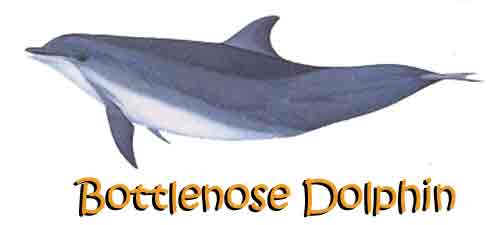
Habitat and Distribution | Physical Appearance |
Behavior | Breeding and Reproduction | Diet | Fun Facts
 Lots More: Sounds, Videos, Etcetera on Marine Mammals Lots More: Sounds, Videos, Etcetera on Marine Mammals
Habitat and Distribution
There are two species of bottlenose dolphins, the common bottlenose dolphin (scientific name: Tursiops
truncatus) and the Indo-Pacific bottlenose dolphin (scientific name: Tursiops aduncus). Bottlenose
dolphins can be found in temperate and tropical waters. They are frequently seen within 20 miles (32 km)
of shore in harbors, bays, lagoons, estuaries, around islands and in large rivers. In the Pacific Ocean, these dolphins range from
northern Japan and southern California, to Australia and Chile. They can also be found in the Atlantic and southwestern
Indian Ocean along with the Baltic, Mediterranean and Black Seas. The only waters in which bottlenose dolphins are not found
are cold waters ranging from 45 degrees poleward in either hemisphere. Some bottlenose dolphins have been known to stay in the
same location throughout their lives, while others have been seen migrating to other parts of the ocean.
Back to the top
Physical Appearance
Bottlenose dolphins are known for their short, thick beaks - hence the name "bottlenose". Their mouths
contain 18 - 26 pairs of sharp cone-shaped teeth on each side of their jaws. Bottlenose dolphins have great flexibility because
they have fewer fused vertebrae in their necks than other dolphins.
Color: The bottlenose dolphin is generally a dark gray on the upper part of its body, fading into
a lighter gray on both sides of its body. The belly color can range from white to light pinkish color.
Length and Weight: Body length ranges from 6 - 12 feet (1.8 - 3.6 meters), with adults typically weighing between
300 - 600 pounds (135 - 295 kg). Males are usually slightly larger than females.
Fins: The dorsal fin of bottlenose dolphins is tall, broad and curved.
Back to the top
Behavior
Bottlenose dolphins are very social animals known for their carefree and playful behavior. Often times,
bottlenose dolphins can be seen living in groups called pods. These groups may contain only a few members or many hundreds
when different pods meet up and join one another. Bottlenose dolphins have been known to hunt in groups, taking turns chasing
through schools of fish or cornering fish against sandbars or mudbanks.
Back to the top
Breeding and Reproduction
Females reach sexual maturity at 5 - 7 years and males reach sexual maturity at 10 - 12 years. Females produce
one offspring every two to three years. Calving takes place at all times of the year with peaks in some areas during the spring
and fall. Calves nurse for over a year (12 - 18 months), and stay with their mothers for up to three years learning how
to catch fish and other important tasks.
Back to the top
Diet
A bottlenose dolphin's diet usually consists of a wide variety of foods including fish, squid and
crustaceans. An adult dolphin may eat 15 - 30 pounds (6.8 - 13.5 kg) of food each day. Bottlenose dolphins do not use their teeth to chew their
food. Instead, they swallow their meal whole and head first to avoid the spines present on many of the fish they like to eat.
Back to the top
Fun Facts
- Bottlenose dolphins are the most studied cetacean in the wild.
- Bottlenose dolphins love to ride the bow waves of boats, so next time you take a boat ride take
a look around to see if you have a dolphin riding with you!
- Bottlenose dolphins have been known to interact with humans. A bottlenose dolphin that was named Percy
resided off the coast of Cornwall, England. He followed local fishing boats, played with their crab pots, and even allowed
strangers to hang onto his dorsal fin as he pulled them through the water.
Back to the top
 Lots More: Sounds, Videos, Etcetera on Marine Mammals Lots More: Sounds, Videos, Etcetera on Marine Mammals
|

